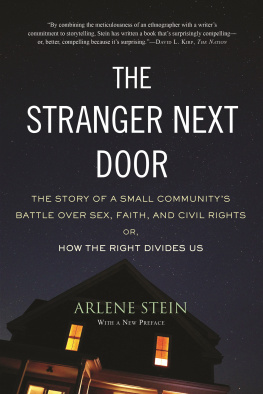Contents
Guide

In memory of Marcy Westerling, and in honor of those who fight for democracy
Up until now, everything around here has always been, well, pleasant. Recently, certain things have become unpleasant. It seems to me that the first thing we have to do is to separate out the things that are pleasant from the things that are unpleasant.
Pleasantville, GARY ROSS, director
Nothing calms better the dread one cannot eradicate than worrying and doing something about the trouble one can fight.
ZYGMUNT BAUMAN, In Search of Politics
PREFACE TO THE NEW EDITION
L ong before Donald Trump occupied the White House, small communities across the Pacific Northwest became laboratories for populist campaigns that exploited peoples fears and turned neighbors against one another. Ill never forget Penny, a white single mother who told me that she resented those who used food stamps to buy avocadoes. I cant afford avocadoes, she lamented, but theyre buying them like theres no tomorrow. Her resentments spilled over in different directions, directed toward immigrants, people of color, uppity city slickers, and anyone else who seemed, to her at least, to work less but have more than she and her family did.
Globalization and automation had shaken the regions timber-based economy, reverberating in small, central Oregon communities like Cottage Grove (which I called Timbertown), where Penny lived. She had lost her job as a nursing assistant, and when her unemployment benefits ran out, she had few other options. During the post-Reagan years of the late 1980s and early 90s, fewer and fewer working- and middle-class Americans could rely upon the government to protect them from economic dislocation. Convinced that the real problem was the decline of traditional values, a small but sizeable minority of them became active in battles around abortion, gay and lesbian rights, and sex education. America, some analysts suggested, was in the midst of a war over our most fundamental and cherished assumptions about how to order our lives.
These were the battles that came to be known as the culture wars. Right-wing activists cast sexual minorities as immoral individuals who went against God, challenged the natural dichotomy of the sexes and the authority of fathers, and exerted an outsize influence. Conservatives charged gays and lesbians with manipulating public officials, including teachers, to carry out their agenda, and they tried to amend the state constitution to prevent antidiscrimination protectionsthe subject of this book. These battles for so-called family values pictured women as producers of the nation whose role was to maintain traditional households, raise children, and support their breadwinner husbands.
In the mid-1990s, I followed Timbertowns battle over gay and lesbian rights to understand what was at stake in the conflict. There, I met a number of true believers who were activists for the cause, mainly politicized Christian evangelicals whose numbers were rapidly growing. The vast majority of people in the community, however, were those, like Penny, who were scrambling to simply find a way to feed their children. Though skeptical about whether rolling back LGBT rights would do a whole lot to make their lives better, they were willing to see if it might. Penny and others took for granted the idea that government was not on their side and was never going to be. As they saw it, if working people were perpetually forced to struggle, with no one to swoop in and save them, they wanted to be damn sure their hard-earned money didnt go to subsidize the profligate lifestyles of others.
The local campaigns against gay and lesbian rights were ultimately defeated. During the 1990s and early 2000s, attitudes toward homosexuality shifted dramatically. In 1973, 70 percent of people felt same-sex relations are always wrong. By 2000, however, that number dropped to 54 percent and by 2010 was down to 43.5 percent. When the US Supreme Court struck down all state bans on same-sex marriage in 2015, some declared that the culture wars were dead. But such pronouncements were premature.
Trump swept into politics articulating many of the resentments I had heard two decades earlier in small towns in the West. The billionaire reality-show star spoke of national decline, promising to drain the swamp and make America great again, using language that was tailor-made for an anxious minority of voters who felt dispossessed, left behind. On behalf of the people, he promised a return to a time when white Christian male dominance seemed more secure. And in the name of protecting the nation, he targeted immigrants, feminists, and LGBT people. Transgender people became a particular focus of popular ire.
CULTURE WARS REDUX
By the new millennium, trans Americans had become more visible and more numerous. They had come to enjoy greater access than prior generations to language and concepts that made the idea of modifying their bodies more imaginable. Trans activists, drawing upon the work of feminists and sexologists, located gender in the mind rather than in the body, defining it as an inner essence of which each individual is the sole legitimate interpreter.
In many respects, activists efforts proved remarkably successful. Under President Obama, Medicare lifted its ban on covering gender surgeries, and federal employees insurance plans quickly followed suit. The Affordable Care Act prohibited discrimination based on gender identity and led the way for a number of states to begin covering gender-transition-related care. Trans activists also won the ability to change gender on passports and the right to use bathrooms consistent with their gender identity, rather than the gender they were assigned at birth.
The right fought back, first with bathroom bills that would prevent trans people from using public bathrooms that align with their gender identity. They focused on the supposed threat posed by transfeminine people to cisgender women and girls, raising the specter of sexual assault. To guard against threats by boys and men masquerading as female, these campaigns sought to re-essentialize sex/gender by compelling those who are assigned the sex of male at birth to use mens bathrooms. Though most of these efforts failed, President Trump signed an executive order rescinding federal protections for transgender students that had allowed them to use bathrooms corresponding with their gender identity, reversing Obama-era policies.
It is notable that on the first day of his administration, President Biden directed all federal agencies that enforce federal laws prohibiting sex discrimination to also prohibit discrimination based on sexual orientation and gender identity. He recognized that transgender Black Americans face unconscionably high levels of workplace
And then, within the first five months of 2021, in a backlash against the progressive policies of the late 1990s and early 2000s, conservatives pushed more than 250 anti-LGBTQ bills into state legislatures around the country, the majority of which targeted trans, nonbinary, and gender-expansive youth. The culture wars were backwith a vengeance.
FEAR OF A GENDER-FLUID PLANET
Christian conservatives have long positioned themselves as saviors of the family against state governments and local school boards that advocate the teaching of sex education, secular humanism, and evolution. While traditionalist notions of gender underpin such efforts, the fight has now turned to the very notion of gender, which the right casts as gender ideology. Affirming essentialist understandings of sex, religious conservatives charge that feminist and queer notions of gender threaten the natural social order, promote homosexuality, and induce gender confusion.











